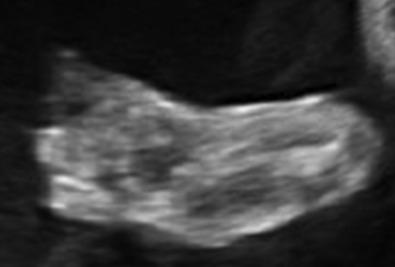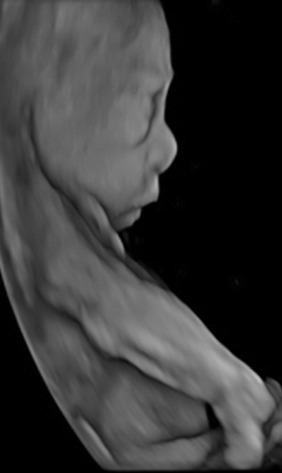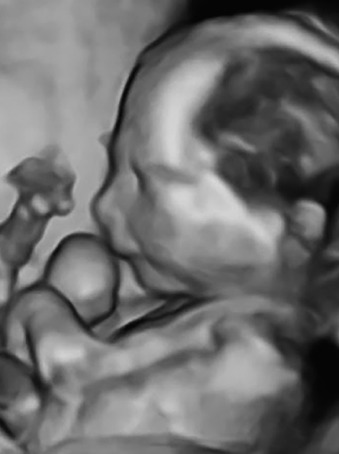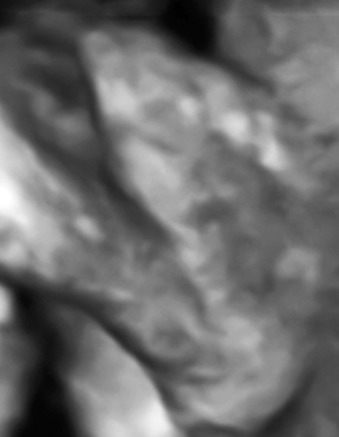Abstract
Congenital contractures are common in the newborn and can include single location contractures that include clubfeet, hip dislocations, and multiple congenital contractures (MCC). Talipes equinovarus, or clubfoot, is an abnormality of the foot position and can be isolated or part of a broader spectrum of anomalies. Clenched hands typically refer to abnormal posturing that can include abnormal positioning of the arms, wrists, and fingers and are often part of congenital contracture syndromes. Characteristic clubfeet show forefoot and midfoot abductus, as well as ankle equinus. On ultrasound, the plantar surface of the foot is persistently visualized in the same plane as the tibia and fibula. For clenched hands or upper extremity arthrogryposis, the shoulders can be internally rotated, the elbows are persistently straight, and the wrists are flexed. A small percentage of fetus with isolated clubfoot have an underlying chromosome abnormality or genetic disorder. However, this contrasts with clenched hands (finger flexion and wrist abnormalities), which present rarely as isolated anomalies.
Keywords
clubfeet, equinovarus, clenched hands, multiple congenital contracture (MCC) syndrome, amyoplasia
Introduction
Congenital contractures in the newborn are actually common, ranging from 1 : 100 to 1 : 200 for some types of contractures that include clubfeet, hip dislocations, and multiple congenital contractures (MCCs). Talipes equinovarus or clubfoot is an abnormality of the foot position. It may be positional, an isolated abnormality, or part of a larger constellation of abnormalities as seen in many genetic syndromes. Clubfoot resulting from in utero positional forces, as may occur with prolonged severe oligohydramnios, multiple gestations, or breech presentations, is not a “true” clubfoot in that the deformity can usually be corrected by manual postnatal manipulation of the foot. Congenital clenched hands are part of MCC syndromes. Fetuses presenting with clubfeet or clenched hands, particularly with more than one joint involved, warrant thorough investigation even if there is a possibility of uterine constraint as an etiology, because constraint is a rare primary cause of contractures, particularly multiple contractures.
Introduction
Congenital contractures in the newborn are actually common, ranging from 1 : 100 to 1 : 200 for some types of contractures that include clubfeet, hip dislocations, and multiple congenital contractures (MCCs). Talipes equinovarus or clubfoot is an abnormality of the foot position. It may be positional, an isolated abnormality, or part of a larger constellation of abnormalities as seen in many genetic syndromes. Clubfoot resulting from in utero positional forces, as may occur with prolonged severe oligohydramnios, multiple gestations, or breech presentations, is not a “true” clubfoot in that the deformity can usually be corrected by manual postnatal manipulation of the foot. Congenital clenched hands are part of MCC syndromes. Fetuses presenting with clubfeet or clenched hands, particularly with more than one joint involved, warrant thorough investigation even if there is a possibility of uterine constraint as an etiology, because constraint is a rare primary cause of contractures, particularly multiple contractures.
Disorder
Definition
Clubfoot describes a range of abnormalities in which the foot is fixed in a plantar-flexed position, and the sole is rotated inward ( Chapter 65 ). The deformity may be unilateral or bilateral and affects the bony, muscular, tendinous, and ligamentous structures. Manual manipulation of the extremity does not correct the defect. Clenched hands typically refer to abnormal posturing that can include abnormal positioning of the arms, elbows, wrists, and fingers. Similarly, bony, muscular, tendon, and ligamentous processes are affected in the upper limb.
Prevalence and Epidemiology
Clubfoot occurs in approximately 1 : 1000 pregnancies and is more common in male fetuses (2 : 1 male-to-female ratio). There is an increased incidence among first-degree relatives. Ethnic variations in frequency exist; it appears to be less common in Asians (0.5 : 1000) and more common in the Polynesian islands (7.5 : 1000 births).
Etiology, Pathophysiology, and Embryology
Many cases of clubfoot, particularly unilateral, are isolated and not associated with other structural or genetic abnormalities. Clubfoot is commonly classified according to intrinsic or extrinsic causes. External forces that deform an otherwise normally developing foot are considered to be extrinsic causes of clubfoot, though controversy exists on the extent of the importance of extrinsic forces on the development of clubfeet, particularly bilateral. While many clubfeet are thought to be isolated, there is compelling evidence from familial and twin studies that there is a higher prevalence of congenital clubfeet in first-degree relatives. Isolated clubfeet have been shown to result from heterozygosity for mutations in the gene encoding PITX1 , thus supporting that some isolated cases of clubfeet result from single gene mutations, though the incidence of single gene disorders among isolated club feet is small. It is estimated that 20% to 25% of clubfoot cases are associated with syndromic etiologies such as MCC, congenital myopathies such as myotonic dystrophy, myelomeningocele with secondary neurologic involvement, amniotic band sequence, and chromosomal syndromes. Other etiologies that increase the risk of clubfeet include maternal smoking. It is critical to recognize that more than 400 genetic disorders are associated with congenital contractures, where the only manifestation of disease in utero may be clubfeet or clenched hands. It is important to recognize that MCC or arthrogryposis, is a highly heterogeneous group of disorders that can affect just the upper limbs, the lower limbs, or both. The most prevalent form of MCC is amyoplasia, accounting for one-third of all cases. It is a sporadic disorder that also has a specific natural history, and the underlying causes are unknown but thought to be vascular in origin.
Manifestations of Disease
Clinical Presentation
Prenatal ultrasound (US) can identify 60% to 80% of cases of clubfoot. In unilateral cases, the defect is more likely to be right-sided. Half of cases of isolated clubfeet are bilateral. However, the precise etiologies underlying the clubfoot or clenched hands are underdiagnosed prenatally, and genetic syndromes are frequently missed. Characteristic clubfeet show forefoot and midfoot abductus ( Fig. 63.1 ), hindfoot varus, and ankle equinus. The foot presents with rigid inward turning toward the midline of the body, resembling a persistent contracted foot. Lower leg muscles are frequently hypoplastic even after correction. Muscle biopsies in cases of amyoplasia, a subset among arthrogryposis syndromes, show replacement of normal muscle tissues with fatty/fibrous tissues. Clenched hands with finger flexion and wrist abnormalities rarely present as isolated anomalies. Clenched hands can be seen in chromosomal anomalies such as trisomy 18, as well as mitochondrial disorders and MCC syndromes. Individuals with clenched hands due to amyoplasia frequently have internal rotation of their shoulders, extended elbows, forearm held in pronation, and wrists rigidly flexed ( Figs. 63.2 and 63.3 ). Similar to lower extremities and clubfeet, clenched hands are associated with decreased muscle mass, decreased flexion creases, and dimples overlying affected joints.



Imaging Technique and Findings
Ultrasound.
Prenatal diagnosis is confirmed if the plantar surface of the foot is persistently visualized in the same plane as the tibia and fibula ( Figs. 63.4–63.6 ). The foot can be seen in midfoot abductus (see Fig. 63.1 ). For clenched hands or upper extremity arthrogryposis, particularly due to amyoplasia, the shoulders can be internally rotated, the elbows are straight, and the wrists are flexed (see Figs. 63.2 and 63.3 ). In cases of MCC, including amyoplasia, there are decreased in utero movements. Because MCC can result from abnormalities in the central nervous system, abnormalities in muscle and nerve development, connective tissue disorders, and osteochondrodysplasias, these respective systems should be thoroughly invested. Amyoplasia is a specific subtype among MCCs and is associated with an increased incidence of gastroschisis, partial absence of digits, constriction rings, and being small for gestational age. Presence of nevus flammeus (“stork bite”) over the facial midline is frequently seen in amyoplasia.











